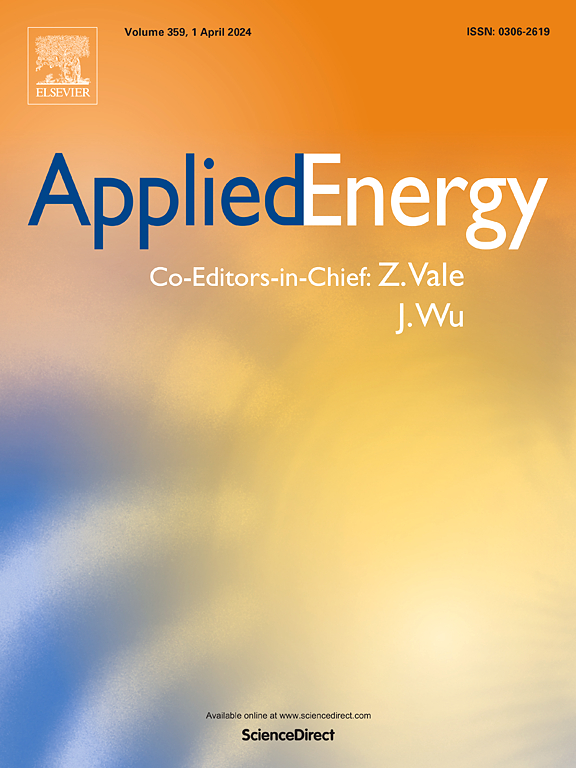Exploring sustainable solutions in PV-integrated indoor farming: Energy, economic, and environmental insights from major U.S. cities
IF 11
1区 工程技术
Q1 ENERGY & FUELS
引用次数: 0
Abstract
As urban populations grow, sustainable local food production becomes essential. Indoor farming with integrated photovoltaic systems offers consistent yields under optimal conditions. This study evaluates photovoltaic-based controlled environment agriculture system in the ten most populous U.S. cities, organized by region—North Central, South Central, Northeast, and Southwest—focusing on energy savings, costs, and environmental impacts. A simulation framework resolves control optimization problems at 15-min intervals, where control outcomes and greenhouse states are analyzed for energy efficiency and environmental effects. The study introduces novel aspects: (1) comprehensive environmental impact assessments, targeting light pollution, carbon footprint reduction, and nitrification; (2) a multi-city evaluation for diverse climate insights; and (3) crop growth modeling within a model predictive control framework, offering a scalable, climate-sensitive solution that optimizes energy efficiency and crop yield. Results show that photovoltaic-based greenhouse can cut annual energy consumption by 25.7 %, reducing reliance on non-renewable sources. Geographic factors influence costs: East and Southwest cities, such as New York and Los Angeles, face increased operational expenses (18 %–26 %) due to land and energy constraints, whereas South Central cities like Houston and Phoenix benefit from lower costs due to ample sunlight. Environmental impacts vary; Northeast photovoltaic-based greenhouse reduces carbon emission emissions by 0.658 kg CO₂-eq/m2 annually but increases light pollution by 5 % in dense urban areas. North Central and South cities experience less light pollution but face nitrification issues, averaging 0.77 N2O eq-kg/m2.
探索太阳能集成室内农业的可持续解决方案:来自美国主要城市的能源、经济和环境见解
随着城市人口的增长,可持续的当地粮食生产变得至关重要。集成光伏系统的室内农业在最佳条件下提供稳定的产量。本研究评估了美国人口最多的10个城市(中北部、中南部、东北部和西南部)的光伏控制环境农业系统,重点关注能源节约、成本和环境影响。模拟框架每隔15分钟解决控制优化问题,其中控制结果和温室状态分析能源效率和环境影响。本研究引入了以下新方面:(1)综合环境影响评价,以光污染、碳足迹减排和硝化为目标;(2)对不同气候见解的多城市评价;(3)在模型预测控制框架内建立作物生长模型,提供可扩展的气候敏感解决方案,优化能源效率和作物产量。结果表明,光伏温室每年可减少25.7%的能源消耗,减少了对不可再生能源的依赖。地理因素影响成本:东部和西南部城市,如纽约和洛杉矶,由于土地和能源限制,运营费用增加(18% - 26%),而南部中部城市,如休斯顿和凤凰城,由于阳光充足,成本较低。环境影响各不相同;东北光伏温室每年减少碳排放0.658 kg CO₂-eq/m2,但在人口密集的城市地区增加了5%的光污染。中北部和南部城市的光污染较少,但面临硝化问题,平均为0.77 N2O当量-kg/m2。
本文章由计算机程序翻译,如有差异,请以英文原文为准。
求助全文
约1分钟内获得全文
求助全文
来源期刊

Applied Energy
工程技术-工程:化工
CiteScore
21.20
自引率
10.70%
发文量
1830
审稿时长
41 days
期刊介绍:
Applied Energy serves as a platform for sharing innovations, research, development, and demonstrations in energy conversion, conservation, and sustainable energy systems. The journal covers topics such as optimal energy resource use, environmental pollutant mitigation, and energy process analysis. It welcomes original papers, review articles, technical notes, and letters to the editor. Authors are encouraged to submit manuscripts that bridge the gap between research, development, and implementation. The journal addresses a wide spectrum of topics, including fossil and renewable energy technologies, energy economics, and environmental impacts. Applied Energy also explores modeling and forecasting, conservation strategies, and the social and economic implications of energy policies, including climate change mitigation. It is complemented by the open-access journal Advances in Applied Energy.
 求助内容:
求助内容: 应助结果提醒方式:
应助结果提醒方式:


